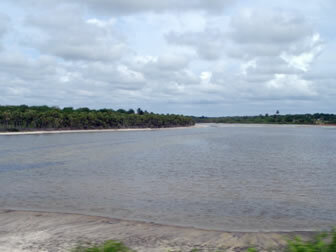The first transport system that used a rail-moving rail mechanism was created in Ancient Greece, around 600 A. a., in the road of Diolkos, region of Corinth. With a route of approximately 8 km, the road served to transport boats and other improvements using the force of animals and slaves.
At the beginning of the 16th century, a transport system formed from wooden rails and pulled by animal traction was developed in Germany, which became known as wagon ways (wagon paths). In Germany, this type of transport was widely used in mineral extraction sites, and even today it is very common in mines around the world use rails to transport ores and to remove water from the bottom of mines.
Around the year 1776 the wooden rails began to be exchanged for iron rails, which characterized the rail way, that is, the railway, a term that ended up being diffused later, in the 19th century. It was in the year 1804 that the first locomotive powered by a steam engine appeared, an innovation created by the British engineer Richard Trevithick. This historic event took place in the English city of South Wales, when 18 tonnes of iron and 70 men were carried 14 km. When the speed reached 8 km/h the tracks did not resist and broke.
With more power and speed, the machines were replacing the horses, providing an increase in the number of wagons and the amount of cargo transported by the trains. From that time onwards, several technical improvements were made to the tracks and locomotives. Railroads have established a different perspective on the idea of carrying heavier loads over long distances. Due to the possibilities of mobility also in urban areas, the railways became an option for the transport of passengers. In this sense, England took the lead in this modality, inaugurating in 1812 in the city of Leeds the first train to transport passengers exclusively.
The year 1830 was marked as the beginning of the Railroad Era, when the first long-running railway line was inaugurated. distance for passengers on a commercial scale and with regular schedules, between the English cities of Liverpool and Manchester. In the first year of operation, the line between these two cities carried 460,000 passengers. In 1863 England created the first underground line, integrating a metropolitan transport system, which was later called metroway.
Between the late 1870s and early 1880s, the first electrically powered railway systems, created by German engineers, were developed. The first railway using electricity conducted by overhead cables was in the year 1883, between the cities of Mödling and Hinterbrühl Tram in Austria.
Do not stop now... There's more after the advertising ;)
At the end of the 19th century, the historical process known as neocolonialism took place, when European nations expanded their colonial explorations. Unlike rich nations, where railroads were built to integrate their territories, railroads established in countries explored had its structure designed to interconnect the areas producing raw materials towards the ports, to facilitate the flow of these products.
In Brazil, the railways also had this characteristic, mainly due to the cycle of coffee, the country's main export product during the second half of the 19th century and the beginning of the century XX. The first Brazilian railroad was inaugurated in 1854, between the Port of Mauá and the city of Fragoso, in Rio de Janeiro, being idealized by businessman and banker Irineu Evangelista de Souza, well known by the title of Barão de Mauá.
The United States used the railroads to complete its occupation process towards the west and the Pacific coast. In the first decade of the 20th century, the United States already had approximately 200 thousand kilometers of railway lines. Brazil, which has a territorial area similar to that of the United States, has barely reached the 40,000 kilometers of railroads built.
A new impetus for the segment was the development of high-speed trains. The first model developed was the Shinkasen, launched in Japan in 1964 and reaching the 200 km/h mark. Since the 1970s, the development of high-speed trains, capable of reaching speeds above 200 km/h, began in England and France. In 1997, Japan launched the Magnalev, a technology based on superconductors, where there is no friction between the train and the rails, and which at its launch reached the 550 km/h mark. In addition to Japan, Germany and China have commercial passenger lines that use superconductivity technology.
Trivia: The French bullet train TGV holds the world record for speed on conventional tracks, with 574.8 km/h. The Japanese train JR-Maglev holds the world record for speed using superconductors, which reached 582 km/h.
Julio César Lázaro da Silva
Brazil School Collaborator
Graduated in Geography from Universidade Estadual Paulista - UNESP
Master in Human Geography from Universidade Estadual Paulista - UNESP
Would you like to reference this text in a school or academic work? Look:
SILVA, Julius César Lázaro da. "A Brief History of Railroads"; Brazil School. Available in: https://brasilescola.uol.com.br/geografia/ferrovias.htm. Accessed on June 27, 2021.



